Scouting History on Display
By Bill Sloan
From the BSA National Scouting Museum in Irving, Tex., to museums in council camps, to small collections in private homes, exhibits of historic Scouting memorabilia are available to the public from coast to coast.
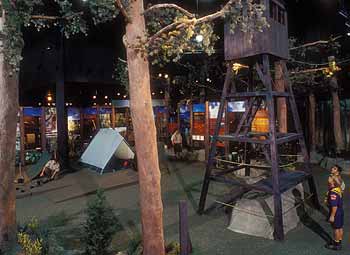 The National Scouting Museum, located next door to the BSA national office in Irving, Tex., is open every day but Wednesday. General admission is $10; Scouters, $5; and students, $6. Photograph by John R. Fulton Jr. |
A solid-brass Scoutmaster's whistle, first blown in 1910, the year the Boys Scouts of America was born...An 85-year-old Scout plow used to promote the cultivation of "victory gardens" during World War I...19th-century souvenirs of the Boer War, once owned by Lord Baden-Powell himself...Faded photos, news clippings, and artifacts that tell the story of a forgotten American hero of World War II...
All these items have one particular thing in common: Each is among the hundreds of thousands of pieces of Scouting memorabilia quietly amassed over the decades by dedicated private collectors across the country.
Maybe you'd like to see a flag that traveled to the moon with Scout and U.S. astronaut Alan Shepard. Or browse through the personal effects of Otis Chidester, who served Scouting actively and continuously for almost 85 years—longer than probably any other man in BSA history. Or view a formation of mannequins dressed in authentic Boy Scout uniforms dating back to 1910.
Some of these collections are housed in local Scouting museums. Others are unusual and extensive enough to merit display space—sometimes entire rooms—in general-interest museums.
A few are featured attractions with permanent quarters at various council Scout camps. Still others are kept at the homes of the collectors, where they are usually available for viewing by Scouts, Scouters, and other interested parties.
Their existence often isn't widely known, since little or no funds are available to promote and advertise them. But wherever you find these collections, they represent a true labor of love for the people who assemble, organize, and oversee them.
Here are five examples of the variety of collections. (Below, you'll find a short listing of more locations.)
Contributing editor Bill Sloan lives in Dallas, Tex.
For Scouts and Scouters in the upper Midwest, a treasure trove of BSA memorabilia is conveniently located at the Ottawa Scouting Museum in Ottawa, Ill.
You'll enjoy visiting a realistic re-creation of the home of William D. Boyce, the Chicago publisher who was instrumental in organizing the BSA 93 years ago after encountering a helpful Boy Scout on a trip to England.
"We attract about 3,000 visitors a year from Illinois, Iowa, Wisconsin, and other states," says Mollie Perrot, a veteran Scouter who serves as executive director of the museum.
"Thanks to our all-volunteer staff, we're able to be open five days a week the year round."
The museum, which also houses Girl Scout and Camp Fire exhibits, sponsors several special annual events including a June pilgrimage to Boyce's gravesite, Perrot points out.
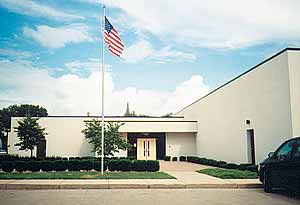 
Among the exhibits in the Ottawa Scouting Museum (above, left) are a totem pole (above, right) made by Troop 102 Scouts, Mendota, Ill.; a re-creation of publisher William D. Boyce's home (bottom, left) ; and BSA uniforms from the 1920's (bottom right). Photographs Courtesy of Ottawa Scouting Museum 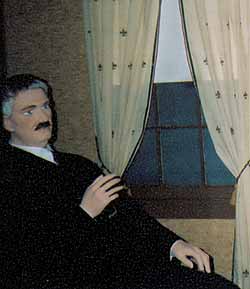  |
At the Clifton Steamboat Museum in Beaumont, Tex., visitors learn about an almost-forgotten Eagle Scout and highly decorated World War II Naval aviator named Harry Brinkley Bass. Glenn Cummings says a major section of the museum's Scouting display celebrates Bass's life and accomplishments.
Actually, Cummings explains, Bass was pretty famous around Beaumont long before he fought the Germans and Japanese from the Pacific to the Mediterranean, won all those medals, and gave his life for his country.
"Brinkley was only 13 when he came home from the world jamboree in England in 1929," recalls Cummings, chairman of the Old Timers Association of the Three Rivers Council, headquartered in Beaumont.
"He was among the first Scouts off the ship when it docked in New York, and he had his picture made with Mayor Jimmy Walker. The photo, along with Brinkley's comments about the mayor, the Prince of Wales's baggy shorts, and other topics, was on the front page of all the New York papers."
Fifteen years later, after fighting in the Battle of the Coral Sea; escaping the sinking of his ship, the aircraft carrier U.S.S. Lexington; and seeing action in the three major theatres of operation of United States troops in World War II, Lieutenant Commander Bass was shot down over France in August 1944. He was awarded the Navy Cross, Gold Star, and other decorations offered by America and her allies. A U.S. Navy destroyer was named in his honor.
Yet, if not for the tireless efforts of Cummings and other memorabilia-conscious veteran Scouters, Bass's amazing story could very well have been lost forever.
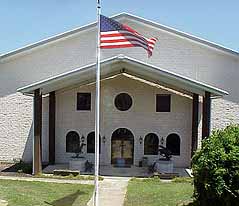 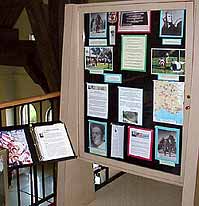 | |
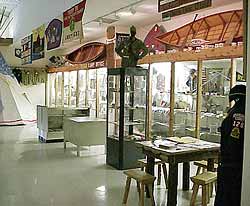
|
A large portion of the Clifton Steamboat Museum displays the heroic exploits of World War II naval aviator and Eagle Scout Harry Brinkley Bass. The Scouting exhibit is maintained by the Old Timers Association of the BSA's Three Rivers Council, headquartered in Beaumont, Tex.
Photographs Courtesy of Clifton Steamboat Museum |
Ever wonder what the first edition of The Boy Scout Handbook looked like and what kind of information it offered to American youngsters back in 1911, the year it was published?
Dick Lange can tell you. Better yet, he can show you.
Lange has two well-preserved copies of the rare old volume—plus every edition of the handbook published since—among the 1,500 Scouting-related books he has accumulated during 25 years of active collecting. He displays them and hundreds of other bits of Scouting history in a small museum behind his home in Mount Shasta, Calif.
A former Scoutmaster, unit commissioner, and merit badge counselor, Lange traces his Scouting career back to Cub Scouts in 1939, but items in his collection go back much further than that. One of his most treasured items is that brass Scoutmaster's whistle mentioned earlier in the story. It was made in England in 1910, the year the BSA was formed; it still blows just as "loud and shrill as ever," Lange says.
"As people heard about my collection, I started getting stuff that belonged to other longtime Scouts," he says. "Among them were five guys from our council, all of whom made Eagle in 1932 and all of whom are still living. Lots of times, I'd see valuable items being thrown out when somebody died, and I just couldn't stand to let that happen."
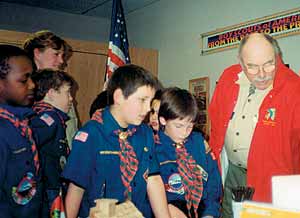 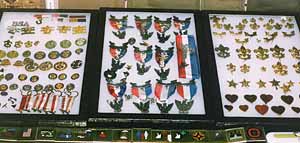
(top, left) Dick Lange gives a tour of his personal Scouting collection to members of Cub Scout Pack 37 of Mount Shasta, Calif. Lange's collection includes knives, patches, uniforms, and books (top, right); vintage first-aid kits (right); and a historical display of rank advancement insignia (above). Photographs Courtesy of Dick Lange |
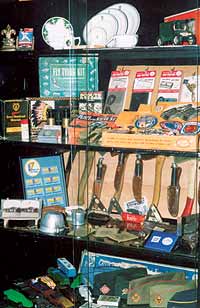
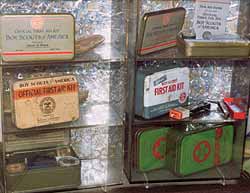 |
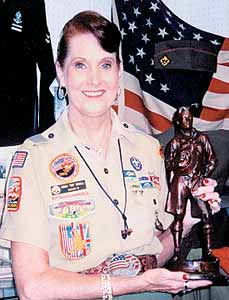
Sidna Small Photographs Courtesy of Sidna Small |
Interest in Scouting memorabilia runs equally deep in Sidna Small of Neodesha, Kan. A member of the executive board of the Quivira Council and the mother of two Eagle Scouts, Small began collecting in the early 1980's.
"At first the collection was for my sons," she says, "but they thought it would be better to share it with others, and they were right. Then, as other people heard about it, things just started coming from all directions."
Since early 1999, Small's ever-growing collection has occupied a room of its own in the general interest Independence Museum in Independence, Kan., where she used her college training in art to design attractive displays for it.
Today, the room contains more items than Small can count. "You could go crazy trying to list each piece," she says.
While the new National Scouting Museum in Irving, Tex., is by far the largest facility of its kind and boasts the most elaborate and extensive exhibits on the Scouting experience, other fascinating displays from Scouting's history can be found in every corner of the country. In fact, the national museum has drawn more than a few of its rare items from private collections.
"We're particularly interested in memorabilia that dates back prior to 1930," says Susan Hardin, the museum's director. "It's a little difficult for us to handle such items on a temporary loan basis, but we're always eager to talk to collectors who would be willing to donate the items for permanent display in the museum."
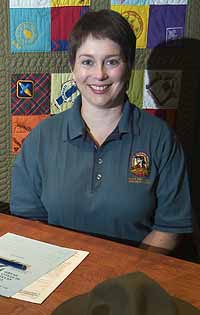 |
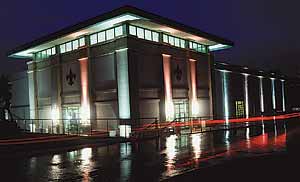 (Left) Susan Hardin, director of the National Scouting Museum (right), oversees a vast collection of Scouting memorabilia. Photographs by John R. Fulton Jr. |
A Sampling of Scouting MuseumsMany privately owned collections of Scouting memorabilia are tucked away in cities and towns all across North America. The examples below, listed alphabetically, only represent a brief sampling of variety and locations. To find more museums and memorabilia collections on the Internet, enter "Scout museums" in the search window of your Internet browser. The Belleville Scout-Guide Museum, Sir James Whitney School, Dundas St. West, Belleville, Ont., Canada. Contains extensive collections of Canadian Boy Scout and Girl Guide memorabilia from the Boer War period to the present, plus a large Scouting library. For information, contact curator David K. Bentley at (613) 968-7605, bvl-sc-gg@rocketmail.com. Central States Scout Museum, 815 Broadway, Larned, Kan., 67550; admission $1 for Scouts, $2 for adults; open daily 9 a.m.-9 p.m. This 4,200-square-foot facility houses one of the largest collections of Scouting memorabilia in mid-America, including many Rockwell figurines and plates, original signed art by Baden-Powell, and an extensive library. A popular stopover for Scouts and leaders traveling to and from Philmont Scout Ranch, the museum is about a day's drive away from the BSA high adventure and training facility in northern New Mexico. For more information, contact curator Charles Sherman, (620) 285-8938, or see http://larned.org/tourism/cssm.html. Otis H. Chidester Museum, 1937 E. Blacklidge Dr., Tucson, Ariz., 85719. Established in 1984 by Otis Chidester, said to be the nation's oldest Scout in terms of continuous, active service (1912-1997), the museum emphasizes Scouting artifacts from Arizona and the Southwest and is one of the world's largest repositories of Scouting records and memorabilia. Its centerpiece is Chidester's vast personal collection obtained during his 85 years of Scouting. For hours of operation and other information, call (520) 326-7669. Clifton Steamboat Museum, 8727 Fannett Rd., Beaumont, Tex., 77705; open Mon.-Fri. 9 a.m.-4:30 p.m. Admission $5 adults, $4 seniors, $4 children (6-15); Scouts in uniform get in for $2 and can earn a Clifton Steamboat Museum patch; group rates available. Features include a 230-ton tugboat and a replica of a 19th-century foundry. World War II hero Harry Brinkley Bass is honored in its gallery of "Heroes Past, Present, and Future," and a special gallery is also devoted to Scouting artifacts. (The Clifton Steamboat Museum Complex includes the two-story, 24,000-square-foot museum; a theater; restaurant; deli; meeting rooms; banquet facilities; and water gardens.) For information, call (409) 842-1910. Hamaker's Encounter With Scouting, Helper, Utah, 84601. A mobile museum of Scouting collectibles that comes to you, it is available for Scoutoramas, awards ceremonies, courts of honor, and district banquets. Dates in the western United States are preferred. Features all types of equipment, uniforms, knives, pins, wall panels, and more. Cost includes a $20 service fee plus travel expenses, food, and lodging. For information, e-mail museum@scoutersattic.com. Independence Historical Museum, Eighth and Myrtle Sts., Independence, Kan., 67301; open Wed.-Sat 10 a.m.-4 p.m., Sun. 1-5 p.m.; $3 donation suggested. One room of this three-story museum is totally devoted to Scouting artifacts, with featured items including historic flags, uniforms, books, badges, and a simulated campsite. For information, contact the museum at (620) 331-3515, www.comgen.com/~museum/index.html, or Sidna Small at (620) 325-2273 or sid@terraworld.net. Dick Lange Collection, Mount Shasta, Calif., 96067; hours by arrangement; admission free. Lange's extensive collection is located in a small building behind his home. In addition to a 1910 Scoutmaster's whistle, the collection includes hundreds of items: knives, adventure books, merit badges from the 1930's and 40's, porcelain Boy Scout figures, a merit badge sash with 92 documented merit badges, and much more. For information, call (530) 926-3684. Lawrence L. Lee Scouting Museum, P.O. Box 1121, Manchester, N.H., 03105; open Sat. 10 a.m.-4 p.m. in Sept.-June, and daily July and August; group tours available; admission free. Operated by the Daniel Webster Council, the museum contains 2,800 square feet of display space, plus the Max I. Silber Scouting Library. Unique exhibits include a flag carried to the moon and back by astronaut Alan B. Shepard Jr. and Boer War memorabilia once owned by Baden-Powell. For information, contact the council at (603) 625-6431, or the museum at (603) 669-8919, www.scoutingmuseum.org. Many Point History Center, c/o Viking Council, 5300 Glenwood Ave., Minneapolis, Minn., 55422. Opened in 1996 as a permanent feature of the Many Point Scout Camp on picturesque Many Point Lake, the center offers one-of-a-kind exhibits on such natural history phenomena as glacier formation and its effect on lakes and landscape, Native American history, forestry and logging, as well as local history. Open during the summer camping season and by special arrangement. For information, contact the council office at (763) 545-4550. Ottawa Scouting Museum, 1100 Canal St., Ottawa, Ill., 61350; open Thurs.-Mon. 10 a.m.-4 p.m.; admission $2 children, $3 adults; special group rates available. This museum houses two major collections from northern Illinois and devotes extensive space to Ottawa native W. D. Boyce, one of the founders of Scouting in the United States. Also included are Girl Scout and Camp Fire exhibits. For information, call (815) 431-9353 or e-mail Mollie Perrot at Scouter07@hotmail.com. Ten Mile River Scout Museum, Ten Mile River Scout Camps, Narrowsburg, N.Y.; open daily in July and August, available by appointment in September-June. Operated by the Greater New York Councils, Empire State Bldg., 350 Fifth Ave., New York, N.Y., 10118-0199, this museum opened in permanent quarters in 1999 to highlight 80 years of the TMR camps' history and the million-plus Scouts from around the world who have camped there. It boasts a collection of historic photos, movies, videos, patches, signs, banners, and physical artifacts, and features a large collection of early Scout uniforms. For information, contact curator Bernie Sussman at (845) 252-3775 or the council offices at (212) 242-1100; see also www.tmrmuseum.org. Washington Scouting Museum, 56550 Stonewyck Dr., Shelby Township, Mich., 48316; open second and fourth Sundays of each month, 1-5 p.m.; admission free. Founded in 1975 by local Scout leader John Dyer-Hurdon, this small museum offers artifacts such as a 1910 BSA uniform, a staff neckerchief from the first national jamboree in 1937, and 400 coffee mugs commemorating Scouting organizations all across the country. For information, contact Dyer-Hurdon at (586) 781-4703. World of Scouting Museum, P.O. Box 2226, Valley Forge, Pa., 19482; open Sat. and Sun., noon-5 p.m., except Dec. 15-Feb. 1; admission $1 children and youth (18 or under), $2 adults. Housed in a large, rustic log cabin, this facility claims the most comprehensive collection of BSA memorabilia in the Northeast. It features such rare historic items as a World War I Boy Scout plow, photographs signed by Lady Baden-Powell, and other one-of-a-kind artifacts. [Due to renovations currently being made, call (610) 783-5311 for information and to verify hours open.] |
November - December 2003 Table of Contents
Copyright © 2003 by the Boy Scouts of America. All rights thereunder reserved; anything appearing in Scouting magazine or on its Web site may not be reprinted either wholly or in part without written permission. Because of freedom given authors, opinions may not reflect official concurrence.